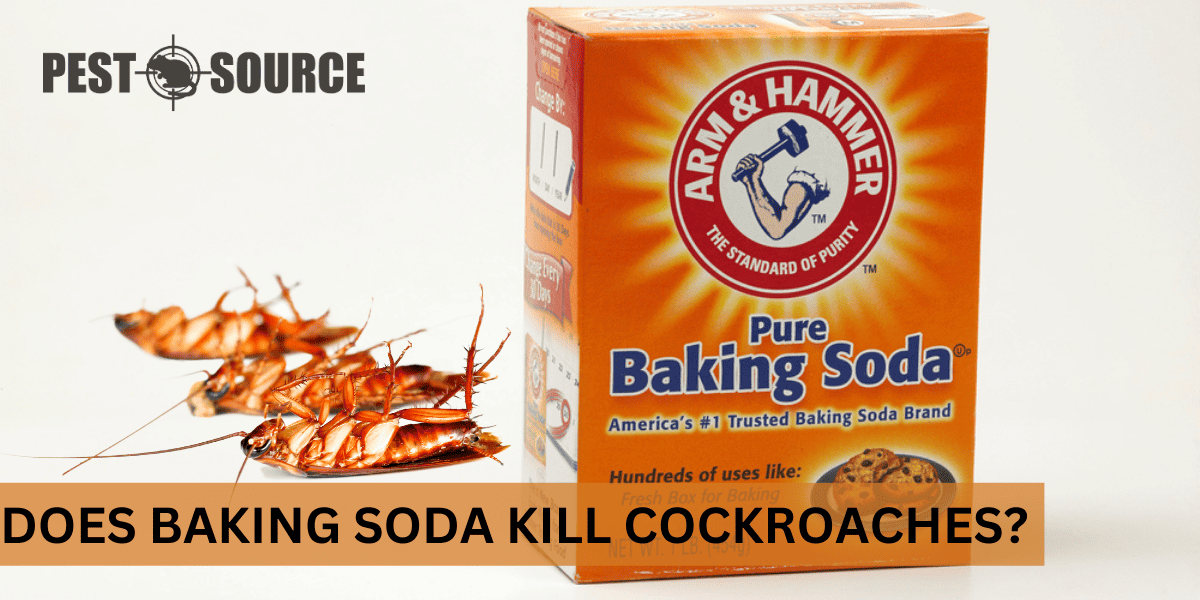Baking soda can be effective in killing cockroaches when mixed with a bait like sugar. In the following sections, we’ll explore how this mixture works and provide tips for using baking soda safely and effectively.
POINTS
- Baking soda is believed to kill cockroaches by causing a chemical reaction in their stomachs when ingested, leading to a buildup of gas and internal pressure.
- The effectiveness of baking soda as a cockroach killer is not scientifically proven and may be less effective than commercial pesticides or other household remedies.
- Baking soda must be combined with an attractant, such as sugar, to lure cockroaches into consuming it, as it is odorless and tasteless on its own.
- While baking soda is a safer and more environmentally friendly alternative to chemical pesticides, it may not be practical for large or severe cockroach infestations.
- Consistent application and strategic placement of the baking soda mixture are crucial for any level of success in controlling cockroach populations.
How Does Baking Soda Work?
Roaches are notorious for their resilience and ability to adapt, making them one of the most persistent pests in homes and businesses. In the quest for effective and affordable pest control solutions, many homeowners turn to common household products. Baking soda, for instance, is often touted as a natural cockroach killer. But does it really work? Let’s delve into the science behind this method and assess its effectiveness.
Assessing the Effectiveness of Baking Soda as a Cockroach Killer
Baking soda, or sodium bicarbonate, is a widely available product that has been claimed to kill cockroaches. However, scientific evidence supporting its effectiveness is limited. Anecdotal reports suggest that when roaches ingest baking soda, it reacts with the acidic substances in their stomachs to produce gas, which can lead to internal pressure and, ultimately, death.
Mechanism of Impact on Cockroaches
When roaches ingest baking soda, it is believed to cause a chemical reaction within their digestive system. Baking soda reacts with the acid in their stomachs, creating carbon dioxide gas. Roaches cannot pass gas, so the buildup of pressure can theoretically be lethal. However, this process relies heavily on the cockroach consuming enough baking soda for the reaction to be fatal.
Comparing Baking Soda with Other Cockroach Killing Methods
To understand the efficacy of baking soda, it’s useful to compare it with other methods:
- Commercial Products: These often contain potent insecticides that can quickly kill roaches on contact or after ingestion. They are scientifically formulated to be highly effective but may contain chemicals that are harmful to humans and pets if not used correctly.
- Household Remedies: Other home remedies include substances like boric acid, diatomaceous earth, and essential oils. While some of these can be effective, their success varies and they may require repeated applications.
Baking soda is less toxic than many commercial products, making it a safer option around children and pets. However, its effectiveness as a standalone treatment is questionable and may not be the best option for severe infestations.
Application and Efficiency: Methods, Timeframe, and Results
Methods of Using Baking Soda to Target Cockroaches
The common method of deploying baking soda as a roach killer involves:
- Mixing with Sugar: Combining baking soda with sugar can attract roaches due to the sweet scent. The sugar entices the roaches to consume the mixture, including the baking soda.
- Baking Soda and Vinegar: Some suggest creating a reaction by luring roaches into a container with baking soda and then adding vinegar, causing a lethal reaction. However, this method is more complicated and less likely to be effective in practice.
Timeframe for Baking Soda to Affect Cockroaches
The time it takes for baking soda to impact roaches can vary. If roaches consume a sufficient amount of baking soda, they may die within hours or days. In contrast, commercial products can work almost instantly or within a few hours.
Factors Influencing Effectiveness and Speed
The effectiveness and speed of baking soda in killing cockroaches depend on several factors:
- Quantity Consumed: Roaches need to ingest enough baking soda for it to be fatal.
- Presence of Water: Like all living creatures, roaches need water to survive. The presence of water can influence the effectiveness of baking soda, as it aids in the chemical reaction that produces gas.
- Infestation Level: For minor problems, baking soda might seem effective, but in the case of a large infestation, more aggressive and proven methods might be necessary.
Behavioral Responses of Cockroaches to Baking Soda: Attraction, Repulsion, and Consumption
Understanding how cockroaches behave in the presence of baking soda is crucial for determining its potential as a pest control method. Cockroaches are survival experts and have evolved to be highly adaptable in various environments, which can influence their interaction with substances like baking soda.
Attraction or Repulsion: Cockroaches and Baking Soda
Baking soda on its own does not have any inherent qualities that either attract or repel cockroaches. It’s an odorless and tasteless substance, so roaches are unlikely to be drawn to it. However, when mixed with sugar or other attractants, cockroaches may be lured by the sweet scent and inadvertently consume the baking soda along with it.
Cockroach Interaction with Baking Soda Mixtures
When using baking soda as a pest control tactic, the success largely hinges on how it’s presented to the cockroaches:
- Baking Soda and Sugar: This mixture can effectively attract cockroaches due to the sugar. Once they consume the mixture, the baking soda can work its intended effect.
- Placement: The placement of the baking soda mixture is also vital. It should be near cockroach hiding spots and along their typical travel paths for the best chance of consumption.
Likelihood and Conditions for Consumption
The likelihood of cockroaches consuming baking soda is higher when it’s mixed with an attractant. However, it’s important to note that cockroaches have a varied diet and may not always choose the bait over other available food sources. Additionally, they are cautious creatures and may avoid an unfamiliar substance after an initial taste.
Baking Soda in Pest Control: Advantages, Limitations, and Safety Considerations
While baking soda is not a magic bullet for cockroach infestations, it does have certain advantages and limitations that are worth considering.
Advantages of Using Baking Soda
- Safety: Baking soda is non-toxic and safe to use around children and pets, which is a significant advantage over many commercial pesticides.
- Affordability: It is an inexpensive and readily available substance.
- Ease of Use: Baking soda is easy to apply and doesn’t require special equipment or protective gear.
Limitations and Drawbacks
- Effectiveness: The effectiveness of baking soda is not scientifically proven and may vary greatly.
- Practicality: It may not be practical for large or persistent infestations where more robust and targeted methods are required.
- Consistency: Baking soda requires consistent application and replenishment to maintain any level of control.
Safety Considerations and Environmental Impact
- Ingestion by Non-target Species: While baking soda is safe, it should still be kept away from food preparation areas to prevent accidental ingestion by pets or young children.
- Environmental Impact: Baking soda is environmentally benign and does not pose the same risks as chemical pesticides, which can contaminate soil and water.
Does Diatomaceous Earth Kill Cockroaches?
Diatomaceous earth can kill cockroaches. Diatomaceous earth is a natural substance made from the fossilized remains of diatoms, a type of algae. It is a powerful desiccant, which means it absorbs moisture from the exoskeleton of insects and causes them to dehydrate and die. When applied in areas where cockroaches are known to frequent, such as cracks, crevices, and behind appliances, diatomaceous earth can effectively control cockroaches. However, it is important to use food-grade diatomaceous earth and wear protective gear when applying it, as the fine dust can be irritating to the lungs if inhaled.



